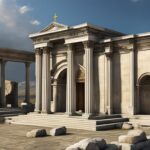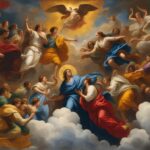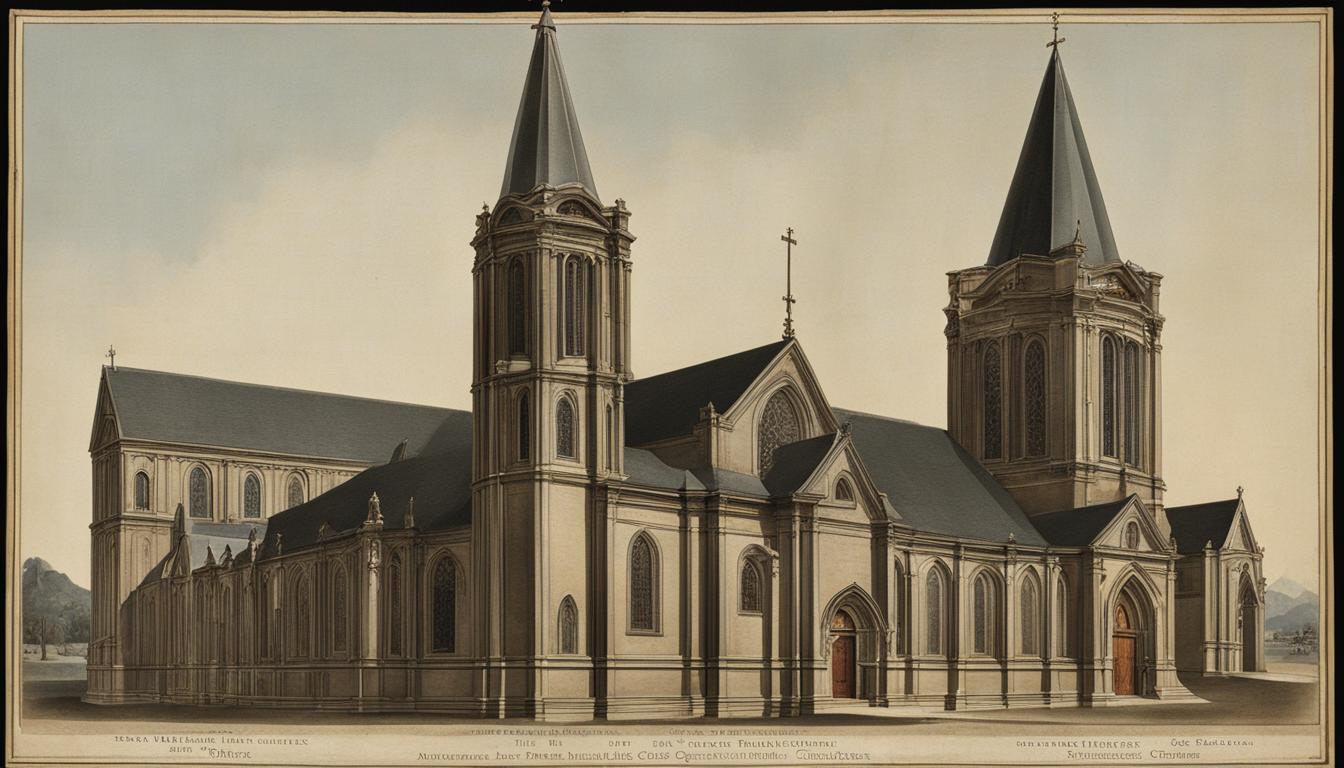The 7 churches mentioned in the Book of Revelation hold significant biblical importance. These churches, also known as the Seven Churches of the Apocalypse and the Seven Churches of Asia, were located in present-day Turkey, specifically in Asia Minor. As instructed by Jesus Christ, John of Patmos wrote letters to these churches, addressing their strengths, weaknesses, and admonitions. The churches include Ephesus, Smyrna, Pergamum, Thyatira, Sardis, Philadelphia, and Laodicea.
Key Takeaways:
- The 7 churches in Revelation were significant centers of early Christianity in Asia Minor.
- Jesus Christ instructed John of Patmos to write letters to these churches, addressing their spiritual conditions.
- The churches were located in Ephesus, Smyrna, Pergamum, Thyatira, Sardis, Philadelphia, and Laodicea.
- The letters contain valuable teachings and lessons that remain relevant for Christians today.
- The 7 churches demonstrate the importance of faith, love, perseverance, and sound doctrine in the Christian faith.
Origins and Background of the Seven Churches
The seven churches mentioned in the Book of Revelation were established during the early years of Christianity in Asia Minor, present-day Turkey. Each church was located in a specific city and played a crucial role in the spreading of the Christian faith. These churches were founded by prominent apostles like Paul and John, who were instrumental in the growth and development of these communities.
The origins of the seven churches can be traced back to the first century AD when Christianity began to spread beyond its Jewish roots. The early Christians faced persecution and challenges, but their unwavering commitment to their beliefs led to the establishment of these churches. These communities became beacons of light in a society dominated by pagan religions, offering hope and guidance to believers.
Asia Minor, where the seven churches were situated, was a significant center of early Christianity. It served as a crucial hub for the spread of the Gospel and the development of Christian theology. The influence of these churches extended beyond their respective cities, impacting the entire region and beyond.
The background of the seven churches is intertwined with the rich history of early Christianity in Asia Minor. These churches thrived amidst cultural diversity and religious pluralism, with believers facing numerous challenges to their faith. Despite these difficulties, the churches remained steadfast, upholding the teachings of Christ and nurturing vibrant Christian communities.
As early Christianity took root in Asia Minor, the seven churches became centers of worship, fellowship, and instruction in the Christian faith. They played a crucial role in shaping the theology and practice of the early church, leaving a lasting legacy that continues to resonate with believers today.
“The origins and background of the seven churches in Asia Minor showcase the growth and resilience of early Christianity, despite the challenges it faced. These churches stood as pillars of faith and beacons of hope in a world dominated by other religions.”
By examining the origins and background of the seven churches, we gain valuable insights into the early days of Christianity and the enduring principles that guided the faith of these communities. Understanding the historical context and cultural landscape in which these churches emerged enables us to appreciate the significance of their contributions to the development of the Christian faith.
| Church | City | Apostle |
|---|---|---|
| Ephesus | Ephesus | Paul |
| Smyrna | Smyrna | Unknown |
| Pergamum | Pergamum | Unknown |
| Thyatira | Thyatira | Unknown |
| Sardis | Sardis | Unknown |
| Philadelphia | Philadelphia | Unknown |
| Laodicea | Laodicea | Unknown |
Beliefs and Doctrines of the Seven Churches
The seven churches of Asia Minor shared a common set of beliefs and doctrines that formed the foundation of their Christian faith. These beliefs centered around the divinity of Jesus Christ, the importance of salvation through faith, and the call to live a righteous life.
At the core of their beliefs was the recognition that Jesus Christ was the Son of God and the Savior of mankind. They held firm to the belief that Jesus, through his death and resurrection, offered redemption and forgiveness of sins to all who put their faith in him.
The seven churches emphasized the need for individuals to have a personal relationship with Jesus Christ and to live out their faith through righteous actions. They believed that faith without works was empty, and that living according to the teachings of Christ was essential for true discipleship.
Each church had its own traditions and practices, but they all held fast to the fundamental doctrines of the Christian faith. They affirmed the authority of the Scriptures and held the teachings of the apostles, particularly Paul, Peter, John, and James, in high regard.
In their worship and spiritual practices, the seven churches emphasized the central role of prayer, worship, and fellowship. They understood the importance of gathering together as a community of believers, supporting one another, and growing together in faith.
Furthermore, the seven churches shared a commitment to spreading the good news of Jesus Christ and engaging in outreach to those outside the Christian faith. They saw themselves as agents of transformation in their communities, showing God’s love through acts of compassion, justice, and service.
Overall, the beliefs and doctrines of the seven churches provided a solid theological foundation for their communities and contributed to the growth and influence of Christianity in Asia Minor during that time.

Doctrines Emphasized by the Seven Churches
| Doctrine | Description |
|---|---|
| Divinity of Jesus Christ | The belief that Jesus Christ is the Son of God, fully divine and fully human. |
| Salvation through Faith | The understanding that salvation is a gift of God received through faith in Jesus Christ. |
| Righteous Living | The call to live a righteous life in accordance with the teachings of Jesus Christ. |
| Authority of Scripture | The recognition of the Scriptures as the inspired and authoritative Word of God. |
| Prayer and Worship | The practice of prayer, worship, and fellowship as integral parts of the Christian life. |
| Community and Outreach | The emphasis on community, support, and outreach to those outside the Christian faith. |
Sacraments and Rituals of the Seven Churches
The seven churches in Asia Minor practiced a variety of sacraments and rituals that held significant importance in their worship and spiritual life. These sacred practices served as tangible expressions of their faith and played a crucial role in their religious ceremonies. The sacraments of the seven churches included:
Baptism
One of the central sacraments practiced by the seven churches was baptism. This rite symbolized the cleansing of sins and initiation into the Christian faith. Through the act of baptism, individuals publicly declared their commitment to Christ and their belonging to the Christian community.
The Eucharist or Communion
Another essential sacrament observed by the seven churches was the Eucharist, also known as Communion or the Lord’s Supper. This sacred ritual involved the sharing of bread and wine, representing the body and blood of Christ. It served as a commemoration of the sacrifice Jesus made for humanity and a symbolic way for believers to partake in His divine grace.
Laying on of Hands
The laying on of hands was an important sacrament practiced by the seven churches for the ordination of clergy and the commissioning of missionaries. This ritual involved the placing of hands on individuals to confer the power and authority of the Holy Spirit upon them. It symbolized the calling and empowerment of individuals for leadership roles within the church.
In addition to these sacraments, the seven churches also had various other rituals and liturgical practices that enriched their worship experience. These included the recitation of prayers, the singing of hymns, the reading of scripture, and the observance of special feast days and festivals.
The sacraments and rituals of the seven churches served as meaningful expressions of their faith and helped foster a sense of community and spiritual connection among believers. Through these sacred practices, the churches sought to deepen their relationship with God and strengthen their commitment to living out the teachings of Jesus Christ.
| Sacrament/Ritual | Description |
|---|---|
| Baptism | The act of cleansing sins and initiation into the Christian faith. |
| The Eucharist or Communion | The sharing of bread and wine, symbolizing the body and blood of Christ. |
| Laying on of Hands | The ordination of clergy and commissioning of missionaries through the laying on of hands. |

Leadership and Clergy of the Seven Churches
The seven churches of Asia Minor were not only centers of worship and spiritual growth but also had a well-defined leadership structure. These churches were overseen by pastors, bishops, and elders who played a crucial role in providing guidance, teaching, and pastoral care to the congregations. Through their leadership, these clergy members upheld the teachings and values of the Christian faith.
Pastors
Pastors, also known as shepherds, were responsible for nurturing and guiding the members of the church. They acted as spiritual leaders, providing counseling, support, and teaching to the congregation. The pastors played a vital role in promoting spiritual growth and fostering an environment of love and unity among the believers.
Bishops
Bishops held a higher level of authority within the church. They were responsible for overseeing multiple congregations within a region and ensuring the proper administration of sacraments and rituals. Bishops were appointed through a process of ordination, and their role included the supervision of pastors, maintaining doctrinal integrity, and resolving disputes within the church.
Elders
Elders, also known as presbyters, were experienced individuals who provided wisdom and guidance to the church community. They played a crucial role in decision-making processes and represented the collective wisdom of the congregation. The elders worked closely with pastors and bishops to ensure the spiritual well-being of the church.
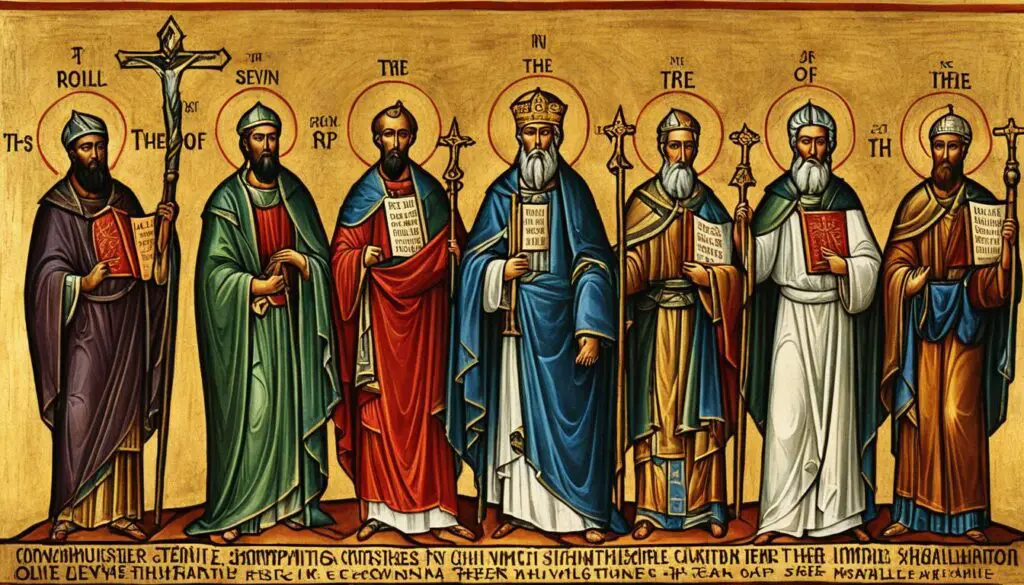
Together, pastors, bishops, and elders formed a hierarchical structure that ensured the smooth functioning of the seven churches. They were entrusted with the responsibility of leading the congregations, promoting sound doctrine, and fostering a sense of unity and love among the believers.
Worship Practices of the Seven Churches
The worship practices of the seven churches played a central role in their spiritual life and community. These practices encompassed a range of activities that helped believers connect with God, express their faith, and deepen their understanding of the Christian message.
Regular gatherings for prayer were a fundamental aspect of worship in the seven churches. Members would come together in unity, lifting their voices in praise and seeking the guidance and presence of God. Prayer was seen as a powerful means of connecting with the divine, and it served as a source of strength and encouragement for believers.
Singing hymns was another integral part of worship in the seven churches. Through hymns, believers expressed their devotion, celebrated their faith, and shared in communal worship. These songs of praise served as a means of expressing love and gratitude towards God, nurturing a sense of unity among the congregation.
Reading and studying scripture held great importance within the worship practices of the seven churches. The Word of God was regarded as a guide for life and a source of spiritual nourishment. By immersing themselves in the teachings of scripture, believers sought to deepen their understanding of God’s will and apply these principles to their daily lives.
Teaching and the exposition of biblical truths were also significant components of worship. Leaders within the churches would share insights, offer guidance, and help believers grow in their faith. These teachings aimed to provide spiritual nourishment, equip believers for their journey, and encourage them to live according to the teachings of Christ.
The seven churches observed special feasts and celebrations, such as Easter and Christmas, which held profound religious significance. These occasions allowed believers to commemorate important milestones in the life and ministry of Jesus Christ, fostering a sense of unity and providing opportunities for reflection and worship.
The liturgical traditions and hymns of the seven churches were unique to each congregation, reflecting the cultural and historical context of the region. These traditions and hymns played a vital role in shaping the worship experience, enabling believers to connect with God on a deeper level and express their faith in a meaningful way.
“Worship is not just a series of rituals; it is a heartfelt expression of our love for God and our devotion to His teachings. Through prayer, praise, and the study of scripture, we draw closer to Him and find guidance and inspiration for our lives.” – Unknown
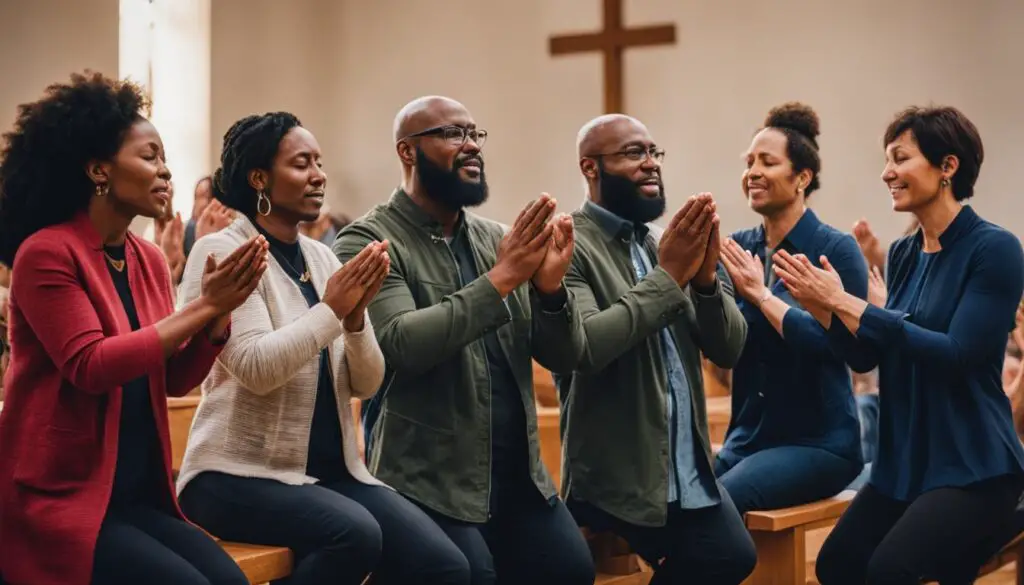
Key Elements of Worship Practices in the Seven Churches
| Elements | Description |
|---|---|
| Prayer | Gatherings for communal prayer to seek the presence and guidance of God. |
| Singing Hymns | Expressing devotion and celebrating faith through communal singing of hymns. |
| Scripture Reading | Studying and reflecting on the Word of God to deepen understanding and spiritual growth. |
| Teaching | Sharing insights and biblical teachings to equip and encourage believers. |
| Special Feasts and Celebrations | Observing significant religious milestones such as Easter and Christmas. |
| Liturgical Traditions and Hymns | Unique practices and hymns reflecting the cultural and historical context of each church. |
Sacred Texts of the Seven Churches
Within the seven churches, the sacred texts held a central role in guiding the beliefs and practices of the Christian communities. These texts were primarily the writings of the apostles, including prominent figures such as Paul, Peter, John, and James. The letters and epistles written by these apostles were considered authoritative and were read and studied in the church gatherings.
The scriptures provided moral guidance, theological teachings, and practical instructions for the members of the seven churches. By studying and meditating on these texts, believers sought to deepen their understanding of God’s will and to navigate the challenges they faced in their faith journeys.
In addition to the New Testament writings, the churches also preserved and transmitted the Old Testament scriptures as part of their religious heritage. The Hebrew Bible, with its wisdom literature, prophetic messages, and historical accounts, formed the backbone of the sacred texts for the early Christian communities in Asia Minor.
Scripture reading in the seven churches was an integral part of worship services. The selected passages were often delivered by the church leaders or respected members of the congregation. These readings served both educational and inspirational purposes, nurturing the spiritual growth and understanding of the believers.
The sacred texts of the seven churches provided the foundation for Christian faith and practice, inspiring believers to live out their calling as followers of Christ.
| Sacred Texts | Significance |
|---|---|
| New Testament Writings | Authoritative teachings from the early apostles |
| Old Testament Scriptures | Preserved religious heritage and historical accounts |

Deepening Spiritual Insights through Scripture
The sacred texts of the seven churches not only provided moral and theological guidance but also served as a source of divine inspiration. The scripture readings during worship services allowed believers to connect with the timeless wisdom and promises contained within these texts.
Through the study and reflection of these sacred writings, believers found solace and strength in times of adversity and were reminded of the enduring truths that guided their faith. The scripture readings united the diverse congregations, fostering a common understanding and shared sense of purpose as they sought to live out the teachings of Christ.
Engaging with the sacred texts was not simply an intellectual exercise but a transformative experience that shaped the hearts and minds of the believers. It deepened their relationship with God and fortified their commitment to love, serve, and share their faith with the world.
Denominations and Sects Among the Seven Churches
Over time, different denominations and sects emerged within the seven churches and the broader Christian community in Asia Minor. These divisions were often based on theological differences, cultural influences, and local traditions. Despite these divisions, the churches still shared a common faith in Jesus Christ.
As Christianity spread and evolved, the seven churches encountered various theological debates and disagreements. Different groups within the churches held contrasting beliefs and interpretations of scripture, leading to the formation of distinctive denominations and sects.
One notable example is the Nicolaitans, mentioned in the Book of Revelation. They were a group within the church of Ephesus known for their acceptance of certain forms of idolatry and immorality. Their teachings were strongly criticized by Jesus and the apostle John. This serves as a reminder of the constant need for vigilance and discernment within the church.
The church of Thyatira also faced challenges from a sect led by a woman called Jezebel, who promoted immorality and the worship of false gods. The church of Philadelphia, on the other hand, was commended for its faithfulness and perseverance, despite facing opposition from a synagogue of Satan.
“Hold on to what you have, so that no one will take your crown.” – Revelation 3:11
These divisions among the seven churches reflect the diverse cultural and religious landscape of Asia Minor during the early days of Christianity. The churches navigated through societal pressures, local customs, and different theological perspectives while striving to remain true to the core teachings of the faith.
“I urge you, brothers and sisters, to watch out for those who cause divisions and put obstacles in your way that are contrary to the teaching you have learned. Keep away from them.” – Romans 16:17
Despite the denominational and sectarian differences, the seven churches continued to share a common foundation of faith in Jesus Christ. They recognized the importance of unity, reconciliation, and love among believers, even in the face of disagreements.
Through the challenges and divisions, the seven churches sought to preserve the teachings of Jesus and serve as beacons of light in their respective communities. Their experiences provide valuable lessons for contemporary Christians, reminding us of the importance of holding fast to our faith while embracing diversity and fostering unity within the body of Christ.
Community and Outreach of the Seven Churches
The seven churches mentioned in Revelation were not only religious institutions but also integral parts of their local communities. They actively engaged in various forms of outreach, embodying the Christian mission in Asia Minor and spreading the message of Christ to those around them.
These churches recognized the importance of providing support for the needy and caring for widows and orphans. They understood that true faith is demonstrated through acts of compassion and generosity. Their commitment to serving the underprivileged served as a testament to their belief in the transformative power of Christian love.
In addition to their work within the community, the seven churches also reached out to those outside the Christian faith. They understood the significance of sharing the good news and inspiring others to join the community of the seven churches. Through their evangelistic efforts, they sought to bring others into the fold, offering a path to salvation and eternal life.
By actively participating in the lives of their community members and sharing the teachings of Christ, the seven churches exemplified the ideals of Christian mission. They fostered an environment of inclusivity and acceptance, inviting individuals from all walks of life to experience the transformative power of faith.
The true value of a church lies not only in its religious practices but also in its ability to positively impact the lives of individuals and the community at large.
Example Table:
| Community Outreach Activities | Description |
|---|---|
| Food Distribution Program | Provided meals and groceries to the less fortunate, ensuring that no one in the community went hungry. |
| Social Services for Widows and Orphans | Offered financial and emotional support to widows and orphans, ensuring their well-being and inclusion in society. |
| Education and Literacy Programs | Established schools and libraries, empowering individuals through education and promoting intellectual growth. |
| Outreach to Non-Believers | Engaged in conversations and activities aimed at sharing the Christian message and inviting others to experience the transformative power of faith. |
| Medical Assistance | Provided medical aid and care to those in need, offering physical healing alongside spiritual guidance. |
Contemporary Issues and Challenges Facing the Seven Churches
Despite the passage of time, the seven churches of Revelation still offer valuable insights into the challenges faced by early Christians and their enduring relevance today. These churches encountered a range of contemporary issues that tested the faith and determination of their members.
Persecution and Opposition
One of the most significant challenges facing the seven churches was persecution. Early Christians faced intense hostility from the Roman Empire, which sought to suppress the spread of the Christian faith. Believers were subjected to imprisonment, torture, and even death for their refusal to renounce their beliefs. Today, many Christians also face persecution in various parts of the world, highlighting the continued relevance of the seven churches’ struggle.
False Teachings and Apostasy
The seven churches grappled with the presence of false teachings and apostasy within their communities. These false teachings undermined the integrity of the Christian faith and posed a threat to the unity of the churches. Today, contemporary churches continue to face the challenge of combating false doctrines and ensuring the preservation of sound biblical teachings.
Religious Pluralism and Pagan Influences
The seven churches existed in a society characterized by religious pluralism and the widespread worship of pagan gods. Christian believers had to navigate the pressures to conform to cultural practices that were incompatible with their faith. Similarly, contemporary Christians face the challenge of living out their faith in a world that promotes diverse religious beliefs and practices.
Moral Decay and Worldliness
The seven churches also confronted issues of moral decay and worldliness among their members. Some individuals compromised their Christian values and engaged in immoral behavior, diluting the message of the Gospel. Today, believers face similar challenges as they strive to uphold biblical principles amidst a culture that often celebrates indulgence and immorality.
Revival and Spiritual Renewal
Amidst these challenges, the seven churches were called to a renewed commitment to their faith and to repentance. They were challenged to rekindle their passion for Christ and overcome complacency. Similarly, contemporary Christians are called to continually seek revival and spiritual renewal, embracing the teachings of the seven churches as a guide.
In exploring the contemporary issues faced by the seven churches, Christians can draw inspiration and guidance for navigating the challenges of their own faith journeys. The lessons learned from these ancient churches offer timeless wisdom for believers seeking to remain faithful, address internal divisions, and stay true to the teachings of Christ in a rapidly changing world.
Lessons from the Seven Churches in Revelation
The seven churches mentioned in the Book of Revelation hold profound lessons and spiritual guidance for Christians today. These ancient churches, founded by apostles such as Paul and John, provide enduring principles that can shape our faith and guide us through the challenges we face.
First and foremost, these churches emphasize the importance of love and compassion. The church of Ephesus, for example, commended for its good deeds, shows us the significance of serving others selflessly. The church of Smyrna teaches us about faithfulness, even in the face of persecution and tribulation. These timeless lessons encourage us to love one another and remain steadfast in our beliefs.
Sound doctrine is another lesson we can learn from the seven churches. The church of Thyatira, known for its intolerance of false teachings, reminds us to hold fast to the truth and discern what aligns with the teachings of Jesus. By staying grounded in sound doctrine, we cultivate a firm foundation for our faith and guard against deception.
Perseverance, even in difficult times, is a recurring theme in the seven churches. The church of Sardis, rebuked for its spiritual complacency, urges us to stay awake and vigilant in our faith. The church of Philadelphia, commended for its endurance, shows us the rewards of remaining faithful and steadfast. These examples inspire us to persist in our spiritual journey, knowing that our perseverance will bear fruit in due time.
FAQ
What are the seven churches in Revelation?
The seven churches in Revelation mentioned in the New Testament are Ephesus, Smyrna, Pergamum, Thyatira, Sardis, Philadelphia, and Laodicea.
Where were the seven churches of Revelation located?
The seven churches were located in Asia Minor, present-day Turkey.
Who established the seven churches?
The seven churches were founded by apostles like Paul and John during the early years of Christianity in Asia Minor.
What were the core beliefs of the seven churches?
The seven churches shared core beliefs in the divinity of Jesus Christ, salvation through faith, and the importance of living a righteous life.
What sacraments and rituals did the seven churches practice?
The seven churches practiced common sacraments such as baptism, communion, and the laying on of hands for ordination. They also had their own ceremonies and liturgical practices.
How were the leaders appointed in the seven churches?
The seven churches had pastors, bishops, and elders who were appointed through a process of ordination and were responsible for the spiritual guidance of the congregations.
What were the worship practices of the seven churches?
The seven churches gathered for prayer, singing hymns, reading scripture, and teaching. They also observed special feasts and had their own liturgical traditions and hymns.
What were the sacred texts of the seven churches?
The sacred texts of the seven churches included the writings of the apostles such as Paul, Peter, John, and James. They also preserved and transmitted the Old Testament scriptures.
Did different denominations emerge among the seven churches?
Yes, over time, different denominations and sects emerged within the seven churches and the broader Christian community in Asia Minor based on theological differences, cultural influences, and local traditions.
How did the seven churches engage in outreach?
The seven churches provided support for the needy, cared for widows and orphans, and reached out to those outside the Christian faith, playing a vital role in spreading the message of Christ in their respective regions.
What challenges did the seven churches face?
The seven churches faced challenges such as persecution, false teachings, and the pressures of living in a pagan society, serving as a reminder to remain faithful and address issues within the church.
What lessons can we learn from the seven churches in Revelation?
The seven churches teach us lessons about love, faithfulness, sound doctrine, and perseverance in the face of challenges. By studying their history and teachings, we can gain insights for our own spiritual journeys.






